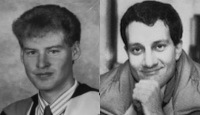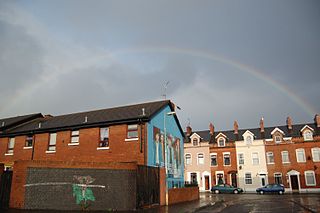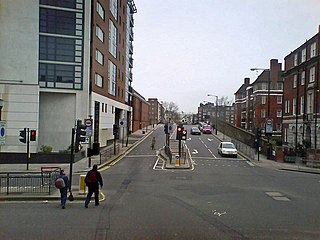
The Irish People's Liberation Organisation was a small Irish socialist republican paramilitary organisation formed in 1986 by disaffected and expelled members of the Irish National Liberation Army (INLA), whose factions coalesced in the aftermath of the supergrass trials. It developed a reputation for intra-republican and sectarian violence as well as criminality, before being forcibly disbanded by the Provisional Irish Republican Army (IRA) in 1992.

Nick Spanos and Stephen Melrose were Australian tourists shot dead in Roermond, the Netherlands by the Provisional Irish Republican Army (IRA) on 27 May 1990, which stated it had mistaken them for off-duty British soldiers. The attack was part of an IRA campaign in Continental Europe.
The Troubles in Ardoyne lists incidents during the Troubles in the Ardoyne district of Belfast, Northern Ireland.
The Derry Brigade of the Provisional Irish Republican Army (IRA) operated in the city of Derry, Northern Ireland, and its surroundings during the Troubles. The Derry Brigade was one of the most active groups in the IRA.
On Tuesday evening 18 November 1975 an Irish Republican Army (IRA) unit nicknamed the Balcombe Street Gang, without warning, threw a bomb into Walton's Restaurant in Walton Street, Knightsbridge, London, killing two people and injuring almost two dozen others.
The 1987 Rheindahlen bombing was a car bomb attack on 23 March 1987 at JHQ Rheindahlen military barracks, the British Army headquarters in West Germany, injuring thirty-one. The large 300 lb (140 kg) car bomb exploded near the visitors officers' mess of the barracks. The Provisional IRA later stated it had carried out the bombing. It was the second bombing in Rheindahlen, the first being in 1973, and the start of the IRA's campaign on mainland Europe from the late 1980s to the early 1990s. Although British soldiers were targeted, most of the injured were actually German officers and their wives.
The Rose & Crown Bar bombing was a bomb attack carried out against a Catholic-owned pub in Belfast. The attack was carried out by the loyalist paramilitary group the Ulster Volunteer Force (UVF) just less than two weeks before the start of the Ulster Workers' Council strike of May 1974 which brought down the Sunningdale power sharing agreement and just 15 days before the UVF carried out the Dublin and Monaghan bombings which killed 34 and injured 300 people, the highest casualty rate in a single day during The Troubles in either Ireland or Britain.
On 11 August 1970, two Royal Ulster Constabulary (RUC) officers were killed by a booby-trap bomb planted under a car by the Provisional Irish Republican Army (IRA) near Crossmaglen, in County Armagh, Northern Ireland. They were the first RUC officers to be killed by republicans during the Troubles and the first security forces to be killed in South Armagh, an IRA stronghold for much of the conflict.

The Lichfield gun attack was an ambush carried out by the Provisional IRA (IRA) on 1 June 1990 against three off-duty British soldiers who were waiting at Lichfield City railway station in Staffordshire. The attack resulted in one soldier being killed and two others badly wounded.

On 18 February 1991 two Provisional Irish Republican Army (IRA) bombs exploded at London mainline stations, one at Victoria station and the other at Paddington station, killing one person and injuring 38 other people at Victoria station. It was the IRA's second major attack in London in February 1991 after the Downing Street mortar attack eleven days earlier which was an attempt to assassinate the British War cabinet and the British prime minister John Major. It was also the first IRA attack against a civilian target in England since the 1983 Harrods bombing, marking a strategic change in their bombing campaign in England.
On 25 and 27 November 1974 the Provisional Irish Republican Army (IRA) placed several bombs in pillar boxes and one in a hedge behind a pillar box. This was a new tactic used by the IRA in England, although a similar tactic had been used in Northern Ireland during The Troubles several times previously. 40 people were wounded from five explosions in several districts.

In the late hours of 3 February and the early hours of 4 February 1973, six men, all of whom were Catholics, were shot and killed in the New Lodge area of north Belfast:

On 2 December 1984, a four-man Provisional Irish Republican Army (IRA) active service unit was ambushed by a British Army Special Air Service team while attempting to bomb a Royal Ulster Constabulary patrol who they had lured to Drumrush Lodge Restaurant. Two IRA volunteers and one SAS soldier were killed during the action.
The Central Bar bombing was a bomb attack on a pub in the town of Gilford near Portadown in County Down in Northern Ireland on 31 December 1975. The attack was carried out by members of the Irish National Liberation Army (INLA) using the covername "People's Republican Army". Three Protestant civilians were killed in the bombing.
The Official IRA's Belfast Brigade was founded in December 1969 after the Official IRA itself emerged in December 1969, shortly after the beginning of the Troubles, when the Irish Republican Army split into two factions. The other was the Provisional IRA. The "Officials" were Marxist-Leninists and worked to form a united front with other Irish communist groups, named the Irish National Liberation Front (NLF). The Brigade like the pre-split IRA brigade before the split had three battalions, one in West Belfast, one in North Belfast and the third in East Belfast. The Belfast Brigade was involved in most of the biggest early confrontations of the conflict like the Falls Curfew in 1970, the battles that followed after the introduction of Internment without trial in 1971 and Volunteers joined forces with the Provisional brigade to fight the British Army and UVF during the Battle at Springmartin in 1972. The first Commanding Officer (CO) of the brigade was veteran Billy McMillen who fought during the IRA Border Campaign. Shortly after the death of Official IRA Belfast "Staff Captain" Joe McCann in April 1972, the battalion structure of the brigade was done away with and command centralized under McMillen.
The following is a timeline of actions during The Troubles which took place in the Republic of Ireland between 1969 and 1998. It includes Ulster Volunteer Force bombings such as the Dublin and Monaghan bombings in May 1974, and other Loyalist bombings carried out in the 1970s, 80s & 90s, the last of which was in 1997. These attacks killed dozens of people and injured hundreds more. Also actions carried out by Irish Republicans including bombings, prison escapes, kidnappings, and gun battles between the Gardaí (police) and the Irish Defence Forces against Republican gunmen from the Irish National Liberation Army, the Provisional Irish Republican Army, and a socialist-revolutionary group, Saor Éire. These attacks killed a number of civilians, police, soldiers, and Republican paramilitaries.

The Chelsea Barracks bombing was an attack carried out by a London-based Active Service Unit (ASU) of the Provisional IRA on 10 October 1981, using remote-controlled nail bomb. The bomb targeted a bus carrying British Army soldiers just outside Chelsea Barracks. The blast killed two civilians and injured 40 people, among them 23 soldiers.

The Irish National Liberation Army Belfast Brigade was the main brigade area of the Irish National Liberation Army (INLA). The other Brigade areas were in Derry which was split between two battalions, the first in Derry City, and the second battalion in south County Londonderry and County Armagh which was also split into two battalions, a south Armagh and a north Armagh battalion, with smaller units in Newry, east and west County Tyrone and south County Fermanagh.
The following is a Timeline of British Army and Royal Ulster Constabulary (RUC) undercover operations during Operation Banner during the 1969 – 1998 Northern Irish conflict in Northern Ireland that resulted in death or injury. Including operations by the SAS, 14 Intelligence Company, the Military Reaction Force (MRF), RUC Special Patrol Group and Special Branch.








